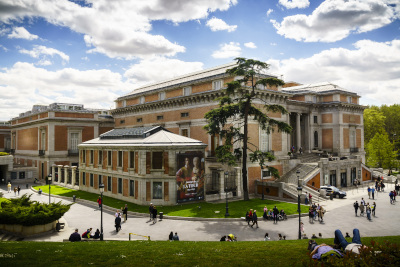This section features museums guides, including the latest exhibitions and the highlights of their permanent collections. Museums and art galleries were traditionally found in the western world, in the main, but in recent times have spread into new regions and cultures. Cities can benefit substantially from hosting a respected gallery or museum, with it helping to attract tourists from far afield.
Our art guides may have something of a western focus, concentrating on art museums and galleries in the US, UK and Ireland in the main, but we will add venues from further afield as this section develops. The ambition is to make the content as inclusive as possible, eventually featuring many different artistic styles and periods within the various collections.
Some of the larger museums featured here will own many hundreds of thousands of items within their permanent collections and will therefore need to rotate their displays fairly regularly. This avoids too many artworks being kept in storage an unseen for potentially decades, whilst also helping to attract repeat visitors who expect fresh content each visit.
In order to encourage all levels of society to visit and enjoy these cultural assets, a growing number of museums and galleries will offer free entry to their permanent collections. They will then attempt to remain profitable through sponsorship deals as well as paid exhibitions. There are also annual passes which gives a variety of benefits such as priority booking and discounts on books and merchandise.
List of Featured Art Museums and Galleries
Types of Art Museums and Galleries
With such a variety of work found under the umbrella of the visual arts, it has been necessary to evolve art galleries and museums onwards from the more traditional layouts and styles. Today we can visit all manner of different galleries, run in different ways. These help to offer opportunities to the full range of artists, from hobbyists, to the Avant-Garde and up to successful, established professional artists.
National and Provincial Art Galleries and Museums
Most developed countries host a selection of art galleries and museums which vary in size and location. Typically, the largest, highest profile venues will be situated in large cities, with smaller offerings dotted around in less built-up areas. There are also often art galleries devoted to a particular artists which are based in their town or village of birth, as a tribute to their achievements.
Artist Spaces
Artist spaces tend to be community-style displays run between a collective of artists. Their purpose is to allow more freedom and less formality within the display area, giving opportunities to a mixture of styles. They can often be set up in cheaper, converted buildings and often appeal more to younger generations, because of their counter-culture atmosphere.
Large cities often have sub-regions which attract many of these types of spaces, creating whole communities of like-minded artists who are looking for creative environments in which to work and exhibit their art. Funding will sometimes be given by charitable organisations in order to fill gaps left by the private sector and mainstream art scene.
Arts Centres
Art centres are large buildings run for the benefit of the local community, and are often funded by local organisations. They typically include areas to encourage the uptake of art techniques, such as places to learn painting, drawing and sculpture in a practical environment. They may also offer courses too.
In being related to the arts more generally, one might also expect to find a theatre located here too, with opportunities for live music as well. Gallery space may be prioritised for encouraging local amateur artists, providing a contrast with established, more formal art galleries and museums.
Online Art Galleries (Virtual Museums)
A growing fashion currently exists around exhibitions which are run entirely online. This was a popular option in recent years when traditional galleries were temporarily shut down, and provided an alternative means by which artists could sell their work, and the public could continue to enjoy this cultural pursuit. Whilst most prefer to see artworks in person, running things online is considerably cheaper and also brings other advantages in using technology.
Several successful innovations included filmed walk-free of existing galleries, sometimes using 3D video software which allows the viewer to simulate looking around each room. Other elements can also be added alongside, such as related merchandise and also interviews with experts or the artists themselves. This option also brings an international audience to the gallery, rather than just those able to physically visit in person.
Vanity Gallery
Vanity galleries charge artists to display their work within their display, for a set period of time. They will be less likely to filter the artists included, and will tend to accept anyone that is willing to pay the required fees. Artists may consider these a worthwhile option if there is sufficient foot fall within the venue, bringing much needed attention to their work, and potentially leading to a number of sales.
Commercial Galleries
These professional displays will typically not charge for artists to display their work, but will take a commission for anything sold directly through the gallery. They will therefore be more choosy in who they allow to display within the gallery, and will typically aim to provide relatively similar styles of art to make each display broadly consistent and in line with their visitors' tastes.
Museum Loans and Collaborations
There is a growing trend of short term loans between different art galleries as a means to curating exhibitions on a particular topic and taking advantage of some of the huge collections found in some of the larger institutions. Logistically, it is fair easier to pull in loans from a few galleries, and often the exhibition can be hosted by each venue in a rotation, allowing them all to take advantage. There will often be relationships in place already, and a level of trust in how each artwork will be taken care of.
Types of Art Mediums Exhibited
The visual arts is a wide ranging umbrella of many different art mediums, and these art catered for by museums and galleries in different ways. The traditional format has always been devoted to paintings, either oil or watercolours, but there are many other options to suit alternative tastes.
Paintings
One immediately thinks of paintings when imagining a gallery. They tend to be the main focal point, and are one of the more flexible items in terms of curating a display. Typically, several will be placed on each wall, but for larger pieces, they maybe given a whole area to themselves. Most valuable paintings will now be kept behind a glass cover for their protection, with a small rail to keep visitors from getting too close.
The most famous art galleries will normally employ experts who can ensure the long preservation of these pieces, as well as using scientific techniques to research the items from time to time. Indeed, we continue to learn new things about artworks centuries-old even today, with x-rays revealing information about the great masters' working practices.
The majority of paintings within art galleries will be in oils. Tempera and fresco works would not transfer as well, whilst mixed media is more of a fashion for 20th century artists alone. Watercolours is a significant niche, but predominantly limited to just a few nations.
Sculptures
A key ingredient of the Italian Renaissance, as well as classical civilisations, is the medium of sculpture. This continues to interest a large number of people and sculpture can often bridge the gap between art gallery and museum. There can often be a great historical significance in the sculpture model too, perhaps representing a key figure from the past.
Sculptures can be displayed by museums and galleries in different ways. In some cases, there can be specific museums only for this art form, whilst in other cases it maybe preferable to display paintings and sculptures together, particularly when the venue is styled similar to a mansion or historical private home. Alternatively, some use sculpture gardens as a means to including horticulture within the same venue, and bringing a further elements of interest for visitors.
Some sculptures can be particularly large and entirely unsuitable for traditional galleries. It would therefore be necessary to store these outdoors, and often museums will think creatively, perhaps by locating the item close to an entrance or exit in order to increase its prominence. Outdoor sculptures will need careful preservation however, and some materials would not be suitable for this due to the impact of weather and climate over an extended period of time.
Drawings and Prints
Whilst some consider drawings and prints to be something of a niche interest in the present day, there is still considerable historical importance in these items. Many artists use them as a means to study drawing techniques from past eras, and to also understand how painters and sculptors would initially plan their work.
Many drawings are somewhat fragile and cannot be shown in the same manner as an oil painting, meaning many are kept stored away in specific departments. They can often be viewed by prior appointment, but must be handled with case. Most major art galleries and museums will have specific departments such as this, with lighting carefully controlled. Many prints exist from techniques such as etching and engraving, which was common during the Renaissance and Baroque eras, particularly in Northern Europe.
Installations
Installation art involves large projects and artworks which may have a temporary nature. Galleries will often devote whole rooms or large halls to these items and often specialists will be needed in order to complete the setup. Guest artists will sometimes be commissioned specifically to create something for a gallery, and the style of these installed pieces can vary widely.
Installation art is particularly fashionable at the moment and offers something different and exciting in comparison to the more traditional methods of curating an exhibition. This can help to attract younger audiences, particularly if the artist chosen is of a high profile or significance within that part of society.
Installed art can include huge sculptures as well as lighting displays. Modern artists continue to strive for new ideas all the time, and this genre is likely to evolve more than any other in the coming decades, potentially taking advantage of new technology.


